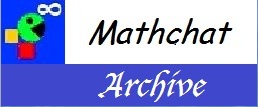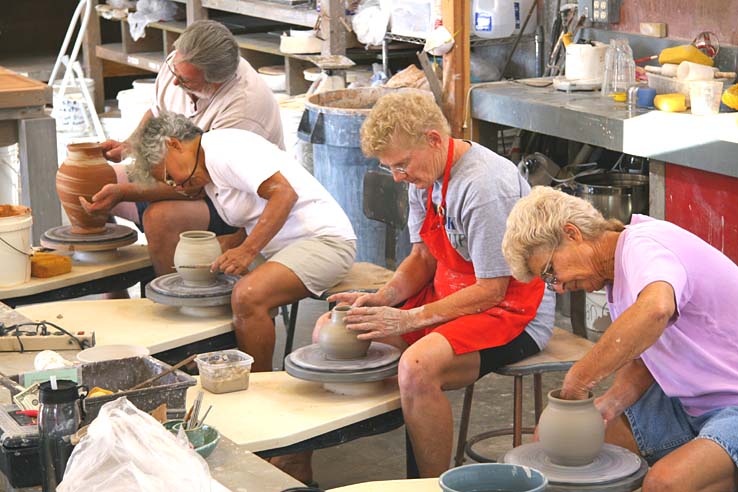To work in groups or not to work in groups? Is that the question?
Posted by: Gary Ernest Davis on: December 7, 2010
 This past Thursday and Monday #mathchat had a Twitter conversation on “Is groupwork or collaborative learning always possible in mathematics?”
This past Thursday and Monday #mathchat had a Twitter conversation on “Is groupwork or collaborative learning always possible in mathematics?”
As one would expect, much of the conversations revolved around whether and under what circumstances groupwork or collaborative learning was possible or desirable in mathematics.
Frequently, contributors discussed what parts of mathematical activity – for example, calculation – might be better carried out individually.
I think it fair to say that my attitude was mostly incredulous.
My comments on Thursday probably indicated as much.
Of course group work and collaborative work is always possible in mathematics,.
Of course sometimes people go off and do calculations by themselves, and at other times not.
What was, or is, the fuss all about?
Then today it hit me.
The discussion was not about group or collaborative work in mathematics.
Rather, it was about school students collaborating, or not, as the teachers saw fit, to solve exercise problems set by the teacher.
In other words, it was not about students doing mathematics, which of course is best done collaboratively.
Rather it was about students doing exercises.
Re-thinking the question
So, I feel the question is not whether groupwork or collaborative learning always possible in mathematics, but whether authentic mathematical activity is possible in school.
If it is, another question is whether it is possible in a significant number, even a majority, of schools.
Is authentic mathematical activity possible in schools?
Yes, it is. I have seen it.
My colleague Nigel Smith, now deceased, would engage his grade 5-8 students at Twyford School in Hampshire, UK in mathematical investigations where he himself did not know an answer, and did not know what route the students would take to a possible solution.
 And James Tanton, who teaches mathematics at St Marks’ school in Southborough, Massachusetts, engages his students in authentic mathematical investigations. Again, he does not always know where the investigation will go or what the students will produce, despite him having a Princeton Ph.D. in mathematics.
And James Tanton, who teaches mathematics at St Marks’ school in Southborough, Massachusetts, engages his students in authentic mathematical investigations. Again, he does not always know where the investigation will go or what the students will produce, despite him having a Princeton Ph.D. in mathematics.
Jim Tanton has written accounts of his work with students in the Mathematical Association of America’s Focus magazine, and regularly discusses mathematical problems on his website and on Twitter, where he is @jamestanton.
Is authentic mathematical activity possible in a majority of schools?
I suspect not.
Not unless a sea-change in teacher confidence, and what’s possible and valued in school mathematics occurs.
It does not require a critical mass of Ph.D. trained mathematicians teaching in schools.
What it does, and will, take is adherence to Lave and Wengers’ idea on legitimate peripheral participation.
Let’s think about the experience of school mathematics from this perspective.
Is school mathematical legitimate activity?
That is, would anyone involved in it – teachers or students – do it if they didn’t have to?
You bet they wouldn’t.
Well that’s not quite correct. Some people would. My former colleague Nigel Smith would – he loved thinking about mathematical problems and how to use those in his classes. James Tanton it seems to me is always thinking about mathematical issues and problems, and also how to use those in his classes.
Doubtless there are many other such mathematics teachers of whom I am unaware.
But many, many teachers I have known would not think a tap more about mathematics if they did not have to teach it.
Their mathematical activity is not legitimate. It is not driven by an inner compulsion, such as a potter has to make pots, or a knitter to knit.
Does school mathematical activity involve peripheral participation by students?
Overwhelming it does not.
Most teachers of mathematics are not masters to their apprentice students.
Their students do not participate in a community of learning with their mathematics teachers.
Students do not start peripherally, carrying out those simpler parts of a mathematical investigation and work their way along to where they are more expert.
Because – most mathematics teachers are not doing mathematics in their classes.
What they are doing is poring through text books to find exercises, or searching high and low for good class activities that might engage their students for a while – keep them productively busy.
The college experience
A Ph.D. in mathematics is no guarantee of legitimate classroom mathematical activity, and legitimate peripheral participation by students.
Just look at the thousands upon thousands of mathematics classes in colleges were students continue to carry out routine and – let’s face it – relatively boring and mind-numbing exercises.
Would the mathematics professor continue to work on these problems left to her or him self?
You bet they wouldn’t.
They might – and only might – go away and think about mathematical problems of an entirely different nature. A Ph.D. in mathematics will do that to you.
Teach mathematics more like pottery
 We are short changing our students by not allowing and encouraging our mathematics teachers to share a passion for mathematical problems
We are short changing our students by not allowing and encouraging our mathematics teachers to share a passion for mathematical problems
Students learn by initiation and by participation – peripheral at first, and more expert as time progresses.
Teachers, though, have to be doing authentic mathematics.
Teaching mathematics should be more like teaching pottery.
Then groupwork or collaboration is not even an issue.

December 8, 2010 at 5:52 am
Thanks for sharing this. I agree that change is needed in order to bring genuine mathematical activity into classrooms. Teacher education is key – we need to give teachers confidence and ‘permission’ to move away from the teaching methods they may be familiar with towards classroom activity that develops mathematical thinking.
December 8, 2010 at 7:41 am
Thanks for this comment, Alison. I wonder if you have any thoughts about how local school districts can provide the necessary support and comfortable space for teachers to try to engage in authentic mathematical activity (as if they were potters!)
December 8, 2010 at 7:53 am
My reply comes from a British perspective as that’s the system I work in. I know of local authority advisors who arrange training for their maths teachers where they have the chance to work on rich mathematical tasks and discuss how to embed them into their classroom practice, but of course this is quite costly. Setting up teacher networks so that innovative teaching can be shared is very important I think, and it’s important that those involved with curriculum design, assessment and school inspection speak out about the importance of getting real mathematics into classrooms. If teachers feel that they will be judged by exam results, or they have to just ‘get through the curriculum’ they will find it much harder to take risks in their teaching.
Finally, can I plug http://nrich.maths.org for anyone who hasn’t found us yet? We try to create genuine mathematical explorations for teachers to use in their classrooms, with strong links to key curriculum areas.
December 8, 2010 at 8:01 am
Thanks for this thoughtful comment, Alison. So you’re with nrich? Great!
I feel – and could be quite wrong about this (my diffidence probably comes from living in the UK for several years!) – that many teachers feel there’s is an authority out there somewhere who knows best.
I am guessing, from my experience, that they are relatively fearful of thinking about mathematics that’s unfamiliar to them and of making mistakes, not realizing that professional mathematicians are making mistakes on a daily basis! (Just getting past them more quickly).
How to encourage mathematical playfulness for and by teachers?
February 16, 2012 at 10:49 am
First, thank you for this. I work with K-8 mathematics teachers who struggle with this ‘problem’ regularly.
Second, I also recommend nrich. I use those problems with teachers to help expand their interest in math learning.
Finally, your question about policy is at the core of the issue. As Alison mentioned (and it is the same here in the U.S.), teaching to standardized assessments and creative problem solving are often viewed as mutually exclusive. Professional learning needs to be more authentic so that comfort with surprise and risk can be increased. Educators can not facilitate math ‘pottery’ if they are unwilling or don’t know how to get their hands into the ‘clay’.